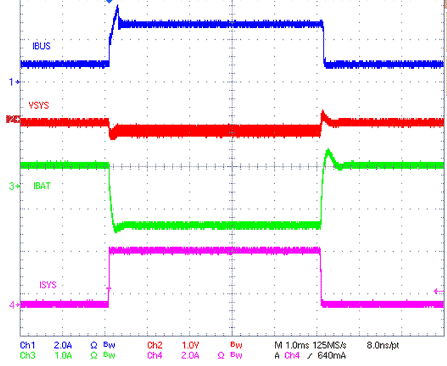JAJSLW9B May 2020 – January 2023 BQ25798
PRODUCTION DATA
- 1 特長
- 2 アプリケーション
- 3 概要
- 4 Revision History
- 5 概要 (続き)
- 6 Device Comparison
- 7 Pin Configuration and Functions
- 8 Specifications
-
9 Detailed Description
- 9.1 Overview
- 9.2 Functional Block Diagram
- 9.3
Feature Description
- 9.3.1 Device Power-On-Reset
- 9.3.2 PROG Pin Configuration
- 9.3.3 Device Power Up from Battery without Input Source
- 9.3.4 Device Power Up from Input Source
- 9.3.5 Dual-Input Power Mux
- 9.3.6 Buck-Boost Converter Operation
- 9.3.7 USB On-The-Go (OTG)
- 9.3.8 Power Path Management
- 9.3.9 Battery Charging Management
- 9.3.10 Integrated 16-Bit ADC for Monitoring
- 9.3.11 Status Outputs ( STAT, and INT)
- 9.3.12 Ship FET Control
- 9.3.13
Protections
- 9.3.13.1
Voltage and Current Monitoring
- 9.3.13.1.1 VAC Over-voltage Protection (VAC_OVP)
- 9.3.13.1.2 VBUS Over-voltage Protection (VBUS_OVP)
- 9.3.13.1.3 VBUS Under-voltage Protection (POORSRC)
- 9.3.13.1.4 System Over-voltage Protection (VSYS_OVP)
- 9.3.13.1.5 System Short Protection (VSYS_SHORT)
- 9.3.13.1.6 Battery Over-voltage Protection (VBAT_OVP)
- 9.3.13.1.7 Battery Over-current Protection (IBAT_OCP)
- 9.3.13.1.8 Input Over-current Protection (IBUS_OCP)
- 9.3.13.1.9 OTG Over-voltage Protection (OTG_OVP)
- 9.3.13.1.10 OTG Under-voltage Protection (OTG_UVP)
- 9.3.13.2 Thermal Regulation and Thermal Shutdown
- 9.3.13.1
Voltage and Current Monitoring
- 9.3.14 Serial Interface
- 9.4 Device Functional Modes
- 9.5 Register Map
- 10Application and Implementation
- 11Power Supply Recommendations
- 12Layout
- 13Device and Documentation Support
- 14Mechanical, Packaging, and Orderable Information
10.2.3 Application Curves
CVBUS = 2*10µF, CPMID= 3*10µF, CSYS = 5*10µF, CBAT = 2*10µF, L1 = 1µH (SPM6530T-1R0M120), Fsw = 1.5MHz.

| VAC1 = VBUS = 5V | VBAT = 8V | |

| VBUS = 5V | VBAT = 8V | ICHG = 1A |

| VBUS = 5V | VBAT = 8V | ICHG = 1A |

| VBUS = 15V | VBAT = 8V | ICHG = 1.5A |

| VBUS = 15V | VBAT = 8V | ICHG = 0A |

| VBAT = 8V | VOTG = 5V | IBUS = 500mA |

| VBUS = 5V | VBAT = 8V | Charge enabled |

| VOC = 10V | VMPP = 8.1V | VBAT = 8V |

| VAC1 = VBUS = 5V | VBAT = 8V | |

| VBUS = 5V | VBAT = 8V | ICHG = 1A |

| VBUS = 8V | VBAT = 8V | ICHG = 1A |

| VBUS = 15V | VBAT = 8V | ICHG = 0A |

| VBAT = 8V | VOTG = 5V | IBUS = 0A |

| VBUS = 15V | VBAT = 8V | Charge disabled |

| VBAT = 8V | VOTG = 5V |

| VOC = 10V | VMPP = 8.1V | VBAT = 8V |